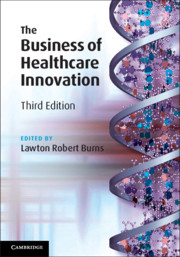Book contents
- The Business of Healthcare Innovation
- Reviews
- Other Cambridge Volumes
- The Business of Healthcare Innovation
- Copyright page
- Dedication
- Contents
- Figures
- Contributors
- Preface
- Acknowledgments
- 1 Product Suppliers in the Healthcare Value Chain
- 2 The Pharmaceutical Sector
- 3 The Biotechnology Sector: Therapeutics
- 4 New Venture Creation in Biotechnology
- 5 The Medical Device Sector
- 6 Financing Medtech Innovation
- 7 The Healthcare Information Technology Sector
- Index
4 - New Venture Creation in Biotechnology
Published online by Cambridge University Press: 24 February 2020
- The Business of Healthcare Innovation
- Reviews
- Other Cambridge Volumes
- The Business of Healthcare Innovation
- Copyright page
- Dedication
- Contents
- Figures
- Contributors
- Preface
- Acknowledgments
- 1 Product Suppliers in the Healthcare Value Chain
- 2 The Pharmaceutical Sector
- 3 The Biotechnology Sector: Therapeutics
- 4 New Venture Creation in Biotechnology
- 5 The Medical Device Sector
- 6 Financing Medtech Innovation
- 7 The Healthcare Information Technology Sector
- Index
Summary
Biotech venture creation is a distinct investment strategy within the broader category of venture capital. It is specialized by both stage and target space and includes four elements: (1) sourcing and seed investing; (2) the role of entrepreneurs in residence (EIRs); (3) building and scaling; and (4) business model selection. Sourcing focuses on identifying innovative science that can be translated into novel therapeutic produces. Seed investing is a critical evaluative stage during which early science is pressure tested with focused resources to stringently determine which new opportunities to advance to full funding and business launch. EIRs, experienced R&D and business executives, play a central role during the seed period and often take on leadership roles in companies that move forward. Finally, matching the science to the business model, whether a broad product platform or a more focused asset-centric company, is a defining step which determines the business, financial, operating, and organizational strategies of new biotech companies. Increasingly, as the biotech industry matures, new venture creation is focused in economic clusters. These clusters are supportive ecosystems with large talent, capital, partner, supplier, and other resource pools that foster key transfers of knowledge, assets, and cooperative assets among industry participants. These clusters are seen across industries and are arguably determined by fundamental economic forces. Early examples include the concentration of textile manufacturing during the middle ages and renaissance in specific cities and regions in England and Italy, the concentration of the automobile industry in Detroit, and the concentration of high- tech companies in the Bay Area in California.
- Type
- Chapter
- Information
- The Business of Healthcare Innovation , pp. 303 - 320Publisher: Cambridge University PressPrint publication year: 2020



